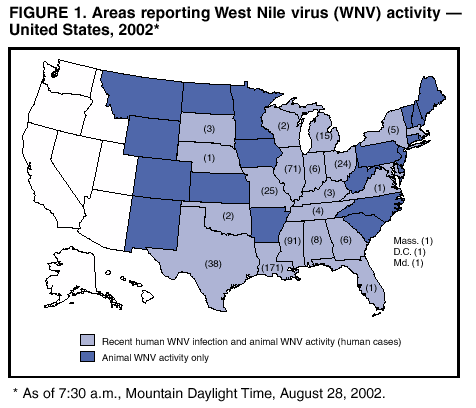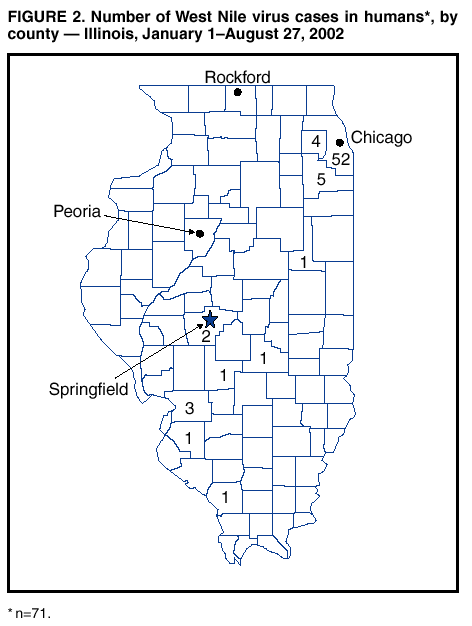 |
|
|
|
|
|
|
| ||||||||||
|
|
|
|
|
|
|
||||
| ||||||||||
|
|
|
|
|
Persons using assistive technology might not be able to fully access information in this file. For assistance, please send e-mail to: mmwrq@cdc.gov. Type 508 Accommodation and the title of the report in the subject line of e-mail. West Nile Virus Activity --- United States, August 21--28, 2002, and Illinois, January 1--August 27, 2002This report summarizes West Nile virus (WNV) surveillance data reported to CDC through ArboNET and by states and other jurisdictions as of 7:30 a.m. Mountain Daylight Time, August 28, 2002, and highlights WNV activity in Illinois. United StatesDuring the reporting period of August 21--28, a total of 210 laboratory-positive human cases of WNV-associated illness were reported from Illinois (n=55), Mississippi (n=36), Louisiana (n=24), Ohio (n=22), Missouri (n=16), Michigan (n=15), Texas (n=13), Georgia (n=six), New York (n=four), Alabama (n=three), South Dakota (n=three), Indiana (n=two), Kentucky (n=two), Oklahoma (n=two), Tennessee (n=two), Wisconsin (n=two), Maryland (n=one), Nebraska (n=one), and Virginia (n=one). During this period, Georgia, Maryland, Michigan, Nebraska, Oklahoma, South Dakota, Virginia, and Wisconsin reported their first human cases for 2002. During the same period, WNV infections were reported in 674 dead crows, 305 other dead birds, 581 horses, and 386 mosquito pools. During this period, WNV activity was reported for the first time ever in Montana and New Mexico. During 2002, a total of 480 human cases with laboratory evidence of recent WNV infection have been reported from Louisiana (n=171), Mississippi (n=91), Illinois (n=71), Texas (n=38), Missouri (n=25), Ohio (n=24), Michigan (n=15), Alabama (n=eight), Georgia (n=six), Indiana (n=six), New York (n=five), Tennessee (n=four), Kentucky (n=three), South Dakota (n=three), Oklahoma (n=two), Wisconsin (n=two), the District of Columbia (n=one), Florida (n=one), Maryland (n=one), Massachusetts (n=one), Nebraska (n=one), and Virginia (n=one) (Figure 1). Among the patients with available data, the median age was 51 years (range: 9 months--98 years), 237 (54%) were male, and the dates of illness onset ranged from June 10 to August 25. In addition, 2,590 dead crows and 1,872 other dead birds with WNV infection were reported from 41 states, New York City, and the District of Columbia; 837 WNV infections in mammals (all but one in horses) have been reported from 25 states (Alabama, Arkansas, Colorado, Florida, Georgia, Iowa, Illinois, Kansas, Kentucky, Louisiana, Minnesota, Mississippi, Montana, Nebraska, New Mexico, New York, North Dakota, Ohio, Oklahoma, South Dakota, Tennessee, Texas, Vermont, Virginia, and Wyoming). During 2002, WNV seroconversions have been reported in 96 sentinel chicken flocks from Florida, Nebraska, Pennsylvania, and New York City; 1,491 WNV-positive mosquito pools have been reported from 18 states (Alabama, Connecticut, Georgia, Illinois, Indiana, Kentucky, Maryland, Massachusetts, Mississippi, Nebraska, New Hampshire, New Jersey, New York, Ohio, Pennsylvania, South Dakota, Texas, and Virginia), New York City, and the District of Columbia. IllinoisIn 2002, a total of 71 persons with laboratory evidence of WNV were reported through August 27, 2002 (Figure 2); 44 cases were laboratory confirmed and 27 were probable. Four cases were fatal; all four patients presented with encephalitis. The 71 patients had a median age of 49 years (range: 2--92 years); 47% were male. The median age for 32 patients with either aseptic meningitis or encephalitis and a known age was 51 years (range: 18--92 years). Patients who died ranged in age from 67 to 92 years. Initial clinical data indicate that 20 patients presented with aseptic meningitis and 17 presented with encephalitis. Nine patients presented with WNV-associated fever. The 25 remaining cases are under investigation. Dates of illness onset ranged from July 14 through August 20. Of Illinois' 102 counties, 92 (90 %) have reported WNV activity (positive animal, mosquito, or human cases). Human cases have occurred among persons in nine counties, with 51 (72 %) cases reported from Cook County, the most populated area of the state. The attack rate during January 1--August 27 was 0.6 per 100,000 for the state population, and 1.0 for Cook County. Of the 709 crows and blue jays tested, 439 (62%) have tested positive for WNV by the immunohistochemistry test; the first bird tested positive on May 15. Sixty-two horses have tested laboratory positive. These horses had specimens collected during July 19--August 23 from 18 counties. Mosquito pools began testing positive on July 11, and 236 mosquito pools have been reported to the Illinois Department of Public Health (IDPH) as positive through August 16. IDPH has provided regular updates on WNV on its Web site (http://www.idph.state.il.us). Information on submission of specimens and clinical information on WNV has been provided to local health departments, infection control practitioners, infectious disease physicians, and hospital laboratories. Special reminders have been sent to schools and campgrounds asking them to inform students, spectators, and campers about mosquito repellents and other protective measures. IDPH has conducted vector control consultations and trainings on larviciding. Prevention messages emphasize the need for personal protective measures and removing containers of standing water around residences. Additional information about WNV activity is available at http://www.cdc.gov/ncidod/dvbid/westnile/index.htm and http://cindi.usgs.gov/hazard/event/west_nile/west_nile.html. Figure 1  Return to top. Figure 2  Return to top.
Disclaimer All MMWR HTML versions of articles are electronic conversions from ASCII text into HTML. This conversion may have resulted in character translation or format errors in the HTML version. Users should not rely on this HTML document, but are referred to the electronic PDF version and/or the original MMWR paper copy for the official text, figures, and tables. An original paper copy of this issue can be obtained from the Superintendent of Documents, U.S. Government Printing Office (GPO), Washington, DC 20402-9371; telephone: (202) 512-1800. Contact GPO for current prices. **Questions or messages regarding errors in formatting should be addressed to mmwrq@cdc.gov.Page converted: 8/29/2002 |
|||||||||
This page last reviewed 8/29/2002
|